THE THEATERS: WHERE ARE THEY NOW?
posted October 5, 2013 1 Comment
![]()
The third and last part of a series. Part One and Part Two appeared during September 2013.
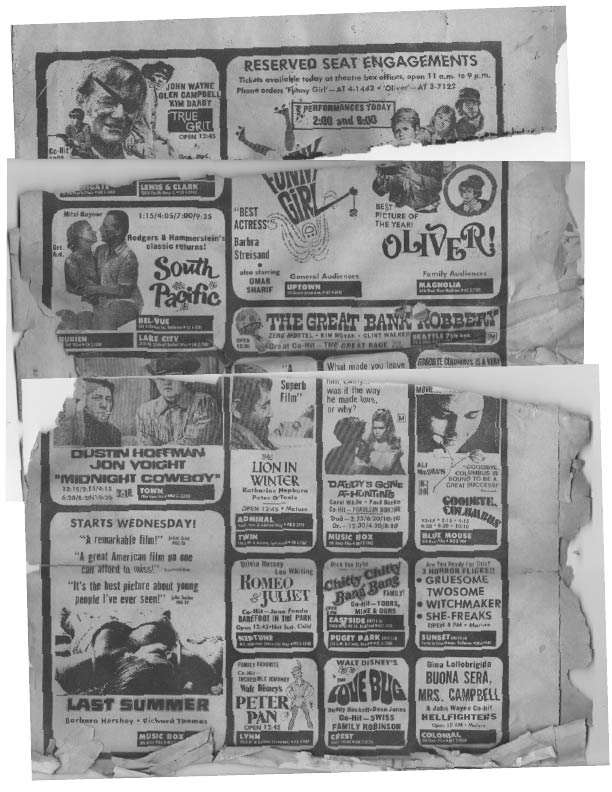 WHAT KIND OF SOCIETAL SELF-LOATHING IS IT that moves us to assign iconic structures to the wrecking ball? Couldn’t we redeploy them – preserve at least the buildings as repositories of cultural memory?
WHAT KIND OF SOCIETAL SELF-LOATHING IS IT that moves us to assign iconic structures to the wrecking ball? Couldn’t we redeploy them – preserve at least the buildings as repositories of cultural memory?
The question is essentially rhetorical. The palaces and humbler movie houses of 1969, not so long ago, are for the most part gone.
A jewel of downtown Seattle movie-going at that time was the 846-seat Music Box, which fairly billed itself as “The Beauty Theatre” of the city. It was a little madcap, too: its huge screen barely fitted in the house.
Cinema Treasures relates that it opened in August 1928 but came to grief with the wrecking back in 1987. That civic accomplishment was among the first I noticed after I came to the city, the previous year.
As the movie pages of August 17, 1969, fell out of my back door’s architrave, under repair, here was the Music Box, again. Its management announced that it was screening Daddy’s Gone A-Hunting – (the 1969 one, not the vaguely related 1925 one): “What made you leave him, Cathy? Was it the way he made love, or why?”
It was the prolific Mark Robson‘s first film after Valley of the Dolls. He would later make a smash-hit Peyton Place, too. The Quebecois, California-schooled lawyer had come to film late, first in props at 20th Century Fox, then at RKO Pictures. By his late 20s, in 1940, he was helping Robert Wise edit Citizen Kane. From there, he was off and running. Among the numerous films he directed was Home of the Brave, a pioneering film critique of racism.
 Fraulein Doktor (1969) ran before Daddy’s Gone A-Hunting. A World War I spy thriller, it apparently has never been released for home viewing, but is one of those films that mysteriously pops up on the usual suspect websites.
Fraulein Doktor (1969) ran before Daddy’s Gone A-Hunting. A World War I spy thriller, it apparently has never been released for home viewing, but is one of those films that mysteriously pops up on the usual suspect websites.
It had a tremendous cast interpreting the tale of a World War I German spy, Fraulein Doktor. She heads a team that readily breaches British and Allied defenses. Her accomplishments cover the waterfront of Mata Hari-like scheming: she seduces whoever she needs to – van driver, brilliant scientist, no matter – to subvert Allied attacks on Germany, crack a cipher and enable a German sub to sink a ship carrying a British admiral, and steal a formula for the mustard gas with which Germany poisoned enemy infantrymen.
The effect of the gas is demonstrated on a battle field in France where German troops slaughter an entrenched French battalion. In voiceover, a Nazi commander boasts that, unlike its enemies, the Third Reich has the courage to deploy the heinous substance, which inflicts chemical-burn blisters and asphyxiates. (The film fudged the battlefield scene, a bit, because the horrific effects of mustard gas rarely emerge within 24 hours.)
A peculiar feature of the film is that the deadly Doktor is portrayed as a rather dreamy, morphine-addicted, virtually effortless seductress. If her vacant eyes betray psychopathy, director Alberto Lattuada makes viewers do most of the detection. And the film’s protagonist exits the film still alive, where virtually all her co-conspirators have appropriately perished.
 What’s more, throughout the dreadful events, Fraülein Doktor remains gorgeous, which aids and abets her gift for seducion. Presumably you don’t make your film’s star ugly even if her soul lacks all empathy – particularly, not when the star is the country-fresh beauty that Suzy Kendall was, at the time. The English former model was much-sought from the mid-1960s to mid-1970s. Fräulein Doktor came about half-way into her film career of only 12 years. (At about the time of the filming, she began four years as the wife of Dudley Moore after co-starring with him in 30 Is a Dangerous Age, Cynthia.) Before playing the Doktor, Kendall had had a bit part in the fourth Bond film, Thunderball (1965) – she went uncredited, but predictably not unexposed, as a “bronzed brunette” within a swing of 007’s dingus. Then she won a prominent role in To Sir, with Love (1967). After Doktor Fraülein, she fronted up in 1970 for a hapless murder suspect who becomes the target of the real killer. That was in The Bird with the Crystal Plumage which made Dario Argento a household name among horror fans.
What’s more, throughout the dreadful events, Fraülein Doktor remains gorgeous, which aids and abets her gift for seducion. Presumably you don’t make your film’s star ugly even if her soul lacks all empathy – particularly, not when the star is the country-fresh beauty that Suzy Kendall was, at the time. The English former model was much-sought from the mid-1960s to mid-1970s. Fräulein Doktor came about half-way into her film career of only 12 years. (At about the time of the filming, she began four years as the wife of Dudley Moore after co-starring with him in 30 Is a Dangerous Age, Cynthia.) Before playing the Doktor, Kendall had had a bit part in the fourth Bond film, Thunderball (1965) – she went uncredited, but predictably not unexposed, as a “bronzed brunette” within a swing of 007’s dingus. Then she won a prominent role in To Sir, with Love (1967). After Doktor Fraülein, she fronted up in 1970 for a hapless murder suspect who becomes the target of the real killer. That was in The Bird with the Crystal Plumage which made Dario Argento a household name among horror fans.
As IMDB puts it, Kendall was a “model of the 60s ‘flower power’ generation whose mini-skirted blonds were the rage – a trendy British version of Sharon Tate. Her film career lasted slightly over a decade, her talent less impressive. Mainly utilized as frightened girlfriends in mod horrors and glamorous temptresses in kooky comedies.”
Fraulein Doktor’s male lead was Kenneth More, an esteemed veteran British actor. Among his qualifications to play the chief British pursuer of the Fraülein, in the war office and in the scenic English and European field, was that whilst a naval lieutenant during World War II, he survived a Nazi bomb run at sea.In the role of Dr. Saforet – not, in reality, the inventor of mustard gas – was Capucine, virtually doubling the film’s star-beauty factor. In his second movie role, Giancarlo Giannini, a later star of Lina Werthmüller films, portrayed the most daring member of the Doktor’s four-man strike force.
Alberto Lattuada directed. In 1950, eight years and eight directing titles into his career, he had co-directed Luci del Varietà, which was Federico Fellini’s first film. Another later Fellini collaborator, perhaps his greatest, Ennio Morricone, created Fraülein Doktor’s at-times extraordinary, metallic, Xenakis-like soundtrack.
The film was based loosely on the intrepid life of Elsbeth Schragmüller, a Prussian doctor of political science turned ace spy. (So were G.W. Pabst’s 1937 French drama film Mademoiselle Docteur (Street of Shadows) and a 1933 Leni Riefenstahl project that was never made because censors stated plainly that its spy theme would be unacceptable.)
N
THIS PROVIDES ME WITH SOMETHING ELSE to complain about.Throughout film and television history, with acknowledgment or not, the epithet “based on real events” or equivalent has been blazoned as some sort of badge of honor, particularly of blockbusters.
Perhaps the marketing wonks claim it puts bums in seats. If that’s true, how lamentable is that? Not because the susceptibilities of viewing publics are particularly here or there. Rather, what’s galling is the abuse of metaphor and other means of literary and film creation that “based on real events” does.
Absurd. Nonsensical.
First, of course it reveals nothing about the extent of adoption or adaptation of historical events. And, the less is the influence, the more meaningless is the “somehow related to historical events.”
Second, if the claim is to have mimicked historical events, the problem becomes that any such attempt defeats itself by the nature of historical fiction.
IT HARDLY REFLECTS WELL ON MANY SCRIPT WRITERS THAT THEY SEEM UNABLE TO CONCEIVE OF A STORY UNLESS SOME HISTORICAL OR REPORTED EVENTS HAPPEN, IN “REALITY,” TO PROVIDE A PLOT.
Third – and most annoyingly – it hardly reflects well on many script writers they seem unable to conceive of a story unless some historical or reported events happen – “reality” – to provide them with a story line to dicker with.
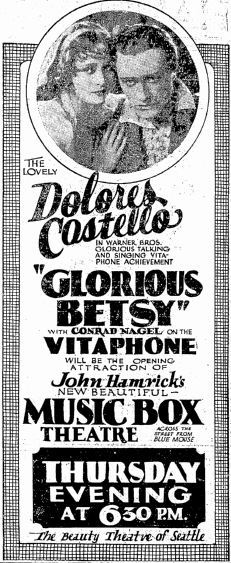
Or, is it – more probably – because the journeymen of film writing are loafing about, devoid of plot ideas, waiting for events to conspire in their favor? “Hey, Bob, a naked women’s brigade of those Somali pirates just lassoed a blimp!”
Might the hacks not doodle with a few narrative ideas of their own?
Is my case overstated? Of course, but only so that my argument might be based on an actual argument.
To put it another way:
Historical fiction, like history of any kind, is a gloss on what actually happened, which itself selects from what actually happened. That’s to say: The more something is fictionally historical, the less claim it has on “fact” – all the more so, because “fact” is already a fudge inherent in historical accounts.
“Whoa,” I hear the objection, “a film ‘based on real events’ claims only to be a fiction, like any fiction.”
It may do. But that claim is self-contradicting: It proposes that a film account’s basis in “real events” means i) less, ii) even less, or iii) nothing. And the advertising boilerplate is either fatuous or disingenuous.
From a more useful perspective: history can’t be real; only fiction can be real; fiction creates reality to the extent that it succeeds as fiction. To put it most nakedly.
OH MY, WHERE WAS I?
Oh, right, the fate of Seattle theaters – a fate duplicated all over the country, and much the world.The claim: cultural larceny is inherent in most demolitions of cinemas, as of any kind of iconic structures, particularly ones with a claim on stylishness of any kind – the elegant, the spectacular, the demotic…
So, the Music Box:
The extraordinary site, Cinema Treasures, tells us that the Music Box opened in 1928 and came to grief with a wrecking ball in 1986. That was a time when elected guardians of the city considered it within their duty of care to wave a green flag at any developer intent on bulldozing historic theaters and other architectural gems.
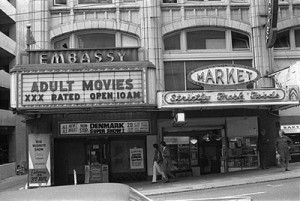
Its golden-age Spanish Renaissance style represented the pinnacle of the career of local architectural icon, Sherwood D. Ford. Its owners managed to have its historical status revoked; a hearings examiner ruled that preservation should not override property owners’ reasonable profit. The city opted for demolition over preservation. The theater’s disassembled façade was auctioned off and placed in storage, to await another entrepreneur’s reasonable profitmaking, next time presumably from kitsch faux nostalgia.
A counter-example of the ruin of the Music Box was the fate of the Embassy Theatre, built in 1926 as a vaudeville house. As Joe Vogel, one of the most generous contributors on Cinema Treasures reports, the architect of the Music Box, Henry Bittman, also had a hand in other downtown theaters. The midtown Embassy didn’t feature in the 1969 Post-Intelligencer listings because by that time, it had devolved to a sad porn cinema and burlesque theater – presumably all are? The space survived because, after sitting dark from 1983 to 2002, it opened as a nightclub, The Triple Door, with lavish renovations of several impressive features, including a handsome proscenium stage.
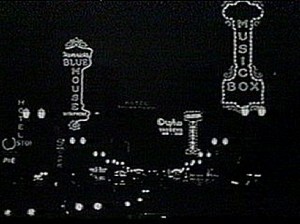
With that term, the bank desecrated the space’s 49-year embrace of metaphor.
Far to the south, by the city airport, was another cinema gem, the Lewis & Clark. True Grit and The Thousand Plane Raid were showing there. The theater was named for the explorers of the American Northwest, who charted a route from the newly acquired territories of the Louisiana Purchase in the South to the Pacific coast – a heroic undertaking known to any citizen of the Pacific Northwest.
But don’t bother to go looking for the Lewis & Clark cinema, now.
The Lewis & Clark was a palace, although of a distinctly American kind. It opened in 1957 as part of an entertainment center that could boast a huge, 32-lane bowling alley. It was, according to an article in The Modern Theatre of 6 April 1957, a 2,100-capacity “symphony in stone, glass, and concrete” – an “ultra-smart…smash hit in Seattle” thanks to a huge Boddie screen of 60 by 28 feet that patrons took in from Kroehler “Push-back” Theater Chairs.Those seats, which long remained state of the art, were an innovation of a southeast Minnesota furniture executive and davenport-bed innovator named Peter E. Kroehler of Kroehler Mfg. Co., which had begun life as the more evocatively titled Naperville Lounge Company. Kroehler had joined the company at 24, and soon was in charge. He was in his mid-60s when, in 1937, his company formed a public-seating division to make the theater chairs.
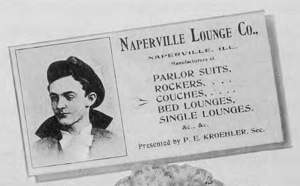 Comfort was a keystone of the Lewis & Clark cinema experience. It had a smoking-and-TV lounge, a kids’ playroom, and a snazzy ladies lounge that patrons at the time could, said The Modern Theatre, “fully appreciate.” Today, a savvy entrepreneur could recreate it as the finest 1950s retro-chic.
Comfort was a keystone of the Lewis & Clark cinema experience. It had a smoking-and-TV lounge, a kids’ playroom, and a snazzy ladies lounge that patrons at the time could, said The Modern Theatre, “fully appreciate.” Today, a savvy entrepreneur could recreate it as the finest 1950s retro-chic.
The establishment’s cafeteria-style snackbar spangled and popped with two Perlick Junior three-drink machines, three self-service Junior Cold-Dislays, four jet-spray bubblers, two Manley Vistapops, one Star popcorn warmer, and three Buttermats.
 You could make a night of it at the Lewis & Clark – bowl, watch a movie, lounge about, and eat enough junk to go home with a belly ache. You could even get schooled. Spun-glass wall panels in the auditorium depicted episodes from Lewis and Clark’s intrepid but unlikely quest.
You could make a night of it at the Lewis & Clark – bowl, watch a movie, lounge about, and eat enough junk to go home with a belly ache. You could even get schooled. Spun-glass wall panels in the auditorium depicted episodes from Lewis and Clark’s intrepid but unlikely quest.
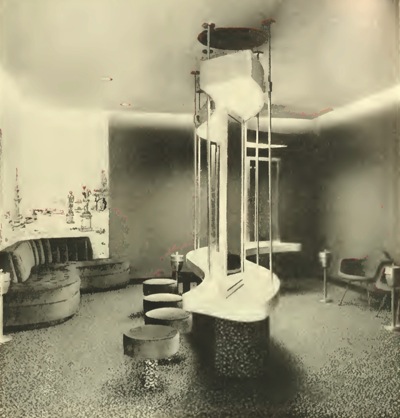
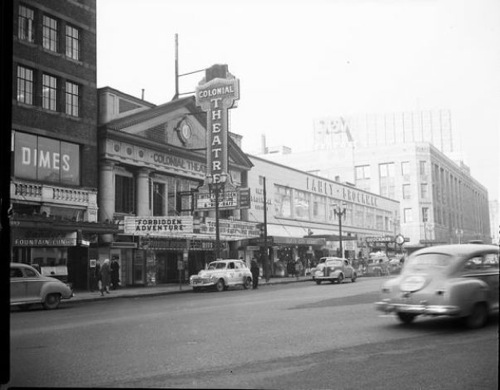
That the device was made from “a motion picture film can and dynamite” is a curious, somehow cinematic detail.
The Colonial’s Greek Revival façade survived until the 1980s until developers accomplished what the bombers could not.
[A note on John Danz: In 1882, when he was five, his family fled Russia due to religious persecution. In 1889, he traveled from east coast to west with his father, in a covered wagon. He worked as a stage driver in Nevada in 1895-1896, and as haberdashery clerk around the West, before opening his own store in downtown Seattle. He ran that from 1903, and when 1913 came, he seized on the growing popularity of films by showing nickelodeon films for a nickel a pop, and then opened a cinema next door. His cinema business flourished – even during the decade-long Great Depression of 1929, on – and kept flourishing until his death in 1961. A storybook American success story!]
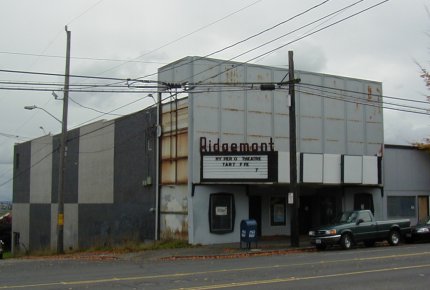
Before that, White notes, the go-to house for art films was the Ridgemont – not on the P-I’s movie page. It was in a neighborhood about five miles north of downtown, and counted among its distinctions that it was the subject of a 1968 United States Supreme Court ruling that invalidated a Seattle film-censorship ordinance. Well, since the mid-1950s it had been showing foreign art films! During that period, recalled local historian Paul Dorpat, “since most of these were foreign films with subtitles, the Ridgemont was considered by some a ‘communist front’ and the lights of its marquee were at risk — pelted often with rocks, eggs, and even excrement.”
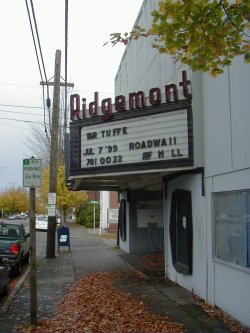
Of course, these days switching cinemas from art to smut hardly seems likely to rekindle demand; perhaps the passing away of porn as a recourse for ailing theaters is part of what is now driving so many theaters into gloom and closure.
The Ridgemont, which has opened in 1919 as Houghton’s 78th Theatre, closed in 1989, fell into disrepair while serving as a local theater company’s props and costumes workshop, and was demolished in 2001.
You wonder what was within its walls.
MY BACK DOOR HAS BEEN OFF ITS HINGES for over three weeks, now. I’d best get back to securing it, and myself. But wait. I almost forget to rail one more time – at a film that was playing in the Seattle area, that week of 17 August 1969: Oliver!
Carol Reed’s 1968 film adaptation of Lionel Bart’s outstanding stage musical was playing in two cinemas. Unforgivably, it omitted some of the best songs, in particular “That’s Your Funeral.” But so, too, had the first Broadway production, in 1963.
(The LP recording featured Davy Jones, pre-Monkees, as the Artful Dodger, while in a 1967 London revival Phil Collins performed as the savvy child pickpocket. The original stage production almost featured Michael Caine. Reportedly he was crushed when he wasn’t chosen to play the sociopathic brute, Bill Sikes, who eventually dispatches Oliver’s lovely protector – and his own paramour – Nancy. The role went instead to a former professional boxer, Danny Sewell. He held the role for almost six years, on the West End as well as the Broadway and American touring productions.)
Leaving out “That’s Your Funeral” can perhaps only be explained by some squeamishness in film’s and the stage musical’s American producers. Had they cut the songs because they considered them too ghoulish for American tastes, however comical? It begins with the observation of the town beadle/charitable institution overseer, regarding Oliver:
He’s a born undertaker’s mute.
I can see him in his black silk suit.
Following behind the funeral procession
With his features fixed in a suitable expression.
The part of the undertaker, Sowerberry, was never better performed than in the original London staging, in 1960 – by Barry Humphries, pre-Edna Everidge, Housewife Superstar. (The full song, with unassociated visuals, is here.)
I wouldn’t have gone to the Hollywood bowdlerization in 1969, just as I can’t imagine stomaching it, now.

Previous Post: ARCHIVE IN A WALL CAVITY II

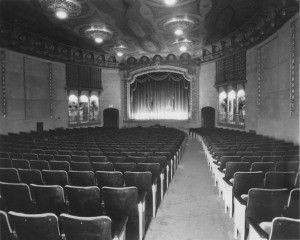
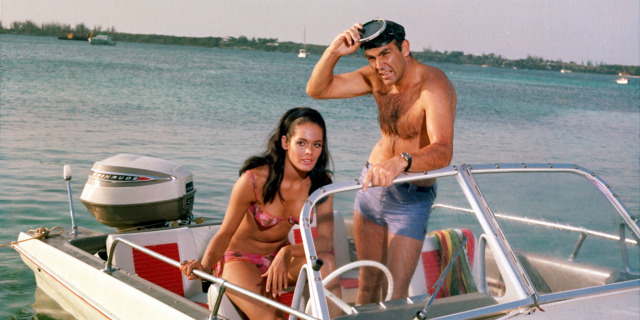
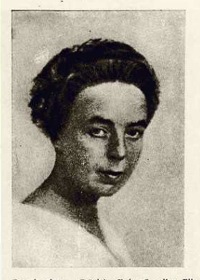
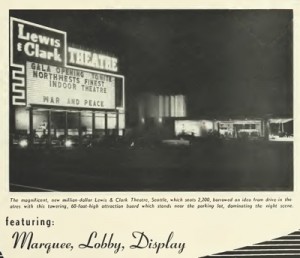
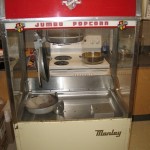
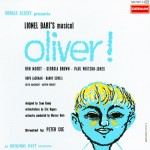



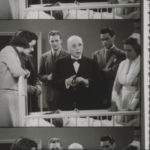

I miss the old downtown Seattle theaters that were a part of my childhood. They had beautiful architectural features and interiors that sadly are gone forever to history. I wish there were more photos available of them. BTW, I used to work for the Neptune Theater when it was part of the Sterling Recreation Organization (SRO) family of theaters.